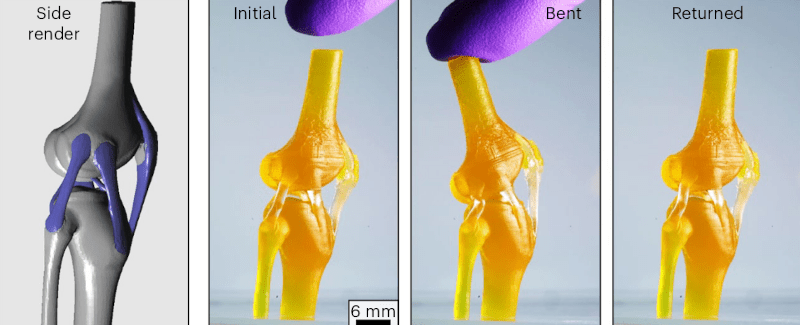Using light to 3D print liquid resins is hardly a new idea. But researchers at the University of Texas at Austin want to double down on the idea. Specifically, they use a resin with different physical properties when cured using different wavelengths of light.
Natural constructions like bone and cartilage inspired the researchers. With violet light, the resin cures into a rubbery material. However, ultraviolet light produces a rigid cured material. Many of their test prints are bio-analogs, unsurprisingly.
Even more importantly, the resin materials connect naturally, so you don’t have as much worry about a piece made with two materials delaminating at the interface. You can control the exact properties by shifting the light frequency one way or another. We read the actual paper, but it wasn’t clear to us if, after curing in a rubbery state, the part could still cure hard in, for example, sunlight. The paper is available in Nature Materials, but if you don’t have a subscription, try your local library or University.
Maybe just the thing for that tunable laser project. Of course, you can use multicolor FDM printers with two types of filaments. You only need to convert the model over.
















Not familiar with the exact chemistry of this project but a few years back I read a paper detailing work with a dual wavelength system in which two different photoinitiators were used. Their chemistry was such that one initiator caused a free radical polymerization, and the other a cationic polymerization. By using two different monomers, each sensitive to one of the two initiators, a part could be produced with two separate material qualities.
In the case of their particular chemistry, the two resulting polymers were chemically distinct from one another so any future exposure would NOT result in any significant change in material properties beyond the expected exposure degradation over time that most polymers suffer.
They seem to work in a current research trend of an epoxy/acrylate couple. Their introduction describe a ton of prior work with this couple, so don’t be surprized if you have seen it before, it’s an improvement.
Do the “rubbery” parts eventualy become solid as exposed to natural daylight? I have experience with all resin prints becoming hard and brittle over time, despite being tough and bendy at first…
No knowledge of this projects chemistry so I cant speak to their’s stability but rather only broadly comment on the issue overall.
Most mSLA resins sold today employ acrylate based chemistries. While most resins will show some degree of hardening and increased brittility over time these are inherently prone to such effect.
UV cured Epoxy, Urethane, Silicone, and Fluropolymer based resins all outperform acrylates in these regards but come with higher prices, more difficulty in printing, and some with greater hazards involved.
https://www.researchgate.net/publication/380307166_Hybrid_Epoxy-Acrylate_Resins_for_Wavelength-Selective_Multimaterial_3D_Printing
the paper is downloadable for free
and a 89 pages supplementary paper:
https://static-content.springer.com/esm/art%3A10.1038%2Fs41563-025-02249-z/MediaObjects/41563_2025_2249_MOESM1_ESM.pdf
and 15 videos:
https://www.nature.com/articles/s41563-025-02249-z#Sec29
“Maybe just the thing for that tunable laser project.”
using optics to combine two dedicated lasers is probably cheaper in the long run.
Id rather spend the extra money on a second galvo so you wouldnt have to run each layer twice.
The 2 channels are simultaneous
https://www.monoprinter.com/pages/mono3-mz
Yeah but they wouldnt be with a tunable laser